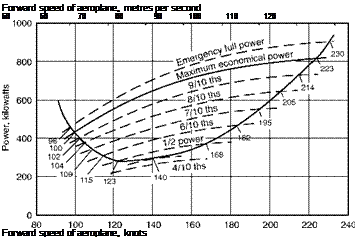Effect of changes of engine power
We have so far assumed that for a certain forward speed of the aeroplane the power available is a fixed quantity. This, of course, is not so, since the power of the engine can be varied considerably by manipulating the engine controls. If the curve shown in Fig. 7.2 represents the power available at some reasonably economical conditions and in weak mixture, then we shall be able to get more power by using rich mixture, and the absolute maximum power by opening the throttle to the maximum permissible boost and using the maximum permissible rpm – with fixed-pitch propellers this will simply be a case of full throttle. From this we shall get a curve of emergency full power (Fig. 7.3, overleaf). It will be noticed that the minimum speed of level flight is now slightly lower – very slightly, so slightly as to be unimportant. The maximum speed is, as we might expect, higher – perhaps not so much higher as we might expect (118 instead of 115 m/s). The most important change is in the rate of climb: 460 kW surplus power is now available for climbing, and the rate of climb is 9.2 m/s instead of 7.2 m/s.
Except in special circumstances, it is inadvisable to fly with the engine ‘flat out’, and, even so, full power must be used only for a limited time or there will be a risk of damage to the engine. The effects of decreasing the power are also shown in Fig. 7.3. From the point of view of the aeroplane, it makes no difference whether the power is decreased by reducing boost, or lowering the rpm, or both; but for fuel economy it is generally advisable to lower the rpm. It will be noticed that as the power is reduced, the minimum speed of level flight becomes slightly greater, the maximum speed becomes considerably less, and the possible rate of climb decreases at all speeds.
 |
Fig 7.3 Effects of engine power
All this is what we might expect, with the possible exception of the fact, which pilots often do not realise, that the lowest speeds can be obtained with the engine running at full throttle. However, this flight condition cannot easily be sustained in practice because a small, inadvertent, decrease in speed would mean an increase in required power and a simultaneous decrease in available power. The speed reduction would then ‘run away’; a condition called speed instability.
Eventually, as the engine is throttled down, we reach a state of affairs at which there is only one possible speed of flight. This is the speed at which least engine power will be used, and at which we shall therefore obtain maximum endurance. It is rather puzzling to find that this speed (72 m/s) is different from the speed (64 m/s) at the lowest point of the power required curve. This is because the engine and propeller efficiency is slightly better at 72 than at 64 m/s.











